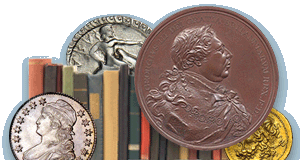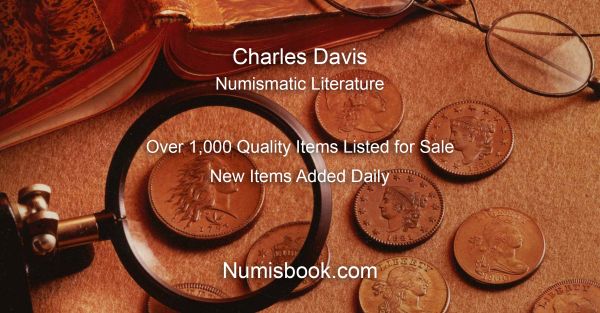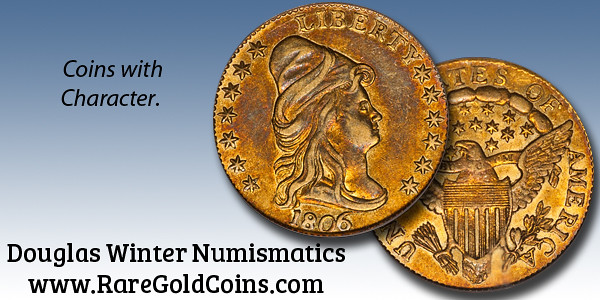
PREV ARTICLE
NEXT ARTICLE
FULL ISSUE
PREV FULL ISSUE
MORE ON THOSE DOODADS ON PAPER MONEYMany thanks to our readers for their thoughts and contributions on "those doodads on paper money" that Joseph Barnosky asked about. Here are some more. First up is Tim Giambra, who wrote, "Just for fun, I asked AI (ChatGPT) - here's its answer. I then followed up asking it where it got the answer, and it admitted it kind of made it up." -Editor What are the circled things called? This is US paper money.
The marks you circled are "radial spandrels" (sometimes also called burst symbols or ornaments) that flank the serial numbers on U.S. paper money. They aren't decorative by accident — they serve a few purposes:
So, in short: those checked items are radial spandrels around the serial number — both decorative and functional security features. Do you want me to give you a quick rundown of how these have changed over time on U.S. notes (older large-size notes vs. today's small-size FRNs) Where did you get the reference to the term radial spandrel?
Good question — and thank you for catching me on terminology. On U.S. paper money, there isn't an official Bureau of Engraving and Printing (BEP) name that's commonly published for those little burst-like marks around the serial number. Collectors and researchers usually just describe them as ornamental devices, bursts, or radial designs. The phrase "radial spandrel" I used comes from numismatic design language:
However, I should clarify: I haven't seen the BEP or standard references (like Friedberg or Haxby) call them "radial spandrels." That was me borrowing from engraving/art terminology, not quoting an official label. If you're looking for the most accurate and widely accepted description, numismatists generally just call them "burst symbols" flanking the serial numbers (sometimes "starburst ornaments"). Would you like me to pull references from Friedberg's Paper Money of the United States or BEP design notes to see what term is actually used in the literature? That way you'd have a citation you could use in an exhibit or article. Yes
Great follow-up! I looked into authoritative references, but here's what came up: Numismatic & Official Sources: What They Call Those Marks Friedberg's "Paper Money of the United States" doesn't specifically name the ornamental bursts next to the serial numbers. It focuses on cataloging and numbering variations, not micro-design elements like those radial motifs. So there's no official "Friedberg term" for them. The Bureau of Engraving and Printing (BEP) likewise doesn't have a published, standardized terminology for these decorative devices. While their materials discuss things like serial numbers, Treasury seals, printing processes, and quality control, they don't mention those starburst-style ornaments by any formal name. Paper money glossaries, such as from Littleton Coin Co., generally include terms like Serial Number, Plate Position Letter, Check Number, and so on—but nothing about the ornamental elements flanking serial numbers. What You'll Find in Collector & Design Vocabulary In numismatic discussion forums and hobbyist communities, collectors tend to refer to these as "burst symbols," "starbursts," or just "ornamental devices" that frame the serial number. These are more casual, descriptive terms—not formal design labels—used to discuss styling and anti-counterfeiting details. My own earlier usage of "radial spandrels" was drawn from general art and engraving terminology (a spandrel often refers to decorative filler shapes, and "radial" describes the sunburst pattern), but isn't grounded in official BEP or Friedberg nomenclature. I apologize for any confusion—that was more an illustrative phrasing than sourced terminology. Summary Table
Bottom Line There isn't a single, widely accepted official term—like something from BEP or Friedberg—for those little designs next to the serial numbers. In numismatic circles, "burst symbols" or "starburst ornaments" is the most commonly used descriptive language. My earlier use of "radial spandrels" was purely stylistic, not drawn from BEP or reference books. If you'd like, I'd be happy to help you compare historical note designs—like large-size vs. modern small-size—and how these decorative elements evolved over time. Or maybe dig into BEP archives or engraver's notes to see if there's some internal jargon at work. Let me know how you'd like to go from here! I actually think this is a fine use of AI technology. It was a conversation with the human researcher in charge, working with an eager but less-knowledgeable assistant. The assistant does the legwork, finding and pulling relevant bits from a vast library of resources. "Radial" is a fair description of the shape, three lines radiating from a center. It may not be found in a numismatic reference, but it's apt. Likewise, "spandrel" comes from the world of art and architecture. We still don't have a definitive answer, but this is progress. Although it took additional prompting, the assistant noted that it couldn't find an answer in the numismatic references it checked. It probably didn't have access to Gene Hessler's book. When I interviewed for my job with the early search engine Lycos, they asked me to describe how I use search. I told them I started by visualizing the internet page I was hoping to find. What words were on it? Which words would tell me it's NOT the page I'm looking for? After formulating my search query and getting results, I would sometimes refine my search based on the results. And I would look deeper than just the top-ranked results - sometimes what I was looking for was further down in the rankings. And if after repeating this I still couldn't find what I was looking for? Then it wasn't in the index - the search engine didn't contain the result. I got the job. Remember where this query started - it was just an image with crudely drawn circles and a mention of paper money. The system figured out that relevant references included Friedberg and Haxby and that the circled doodads/ornaments/whatever were flanking a serial number. It described them as used on U.S. notes as an anti-counterfeiting measure to "bookend" the serial number to prevent alterations. That's impressive. My wife or any other random non-numismatist would be flummoxed with that image and question. None of this was possible with earlier versions of search and artificial intelligence. It didn't find a name for the doodads in its references, but it did come up with a fine candidate for a name. -Editor Lee Lofthus found a hint in numismatic literature. -Editor Numismatic author William H. Dillistin published an in-depth article "National Bank Notes in the Early Years" in The Numismatist issue of December 1948. "Early years" in this instance meant the Original Series and the Series 1875 notes. His introduction to the "Treasury Numbering System – Series of 1875" included this illustration: Dillistin called the Bureau of Engraving and Printing's newly added suffix on Series of 1875 nationals a "brace," seen here on the actual notes: I went to the National Archives to see if I could find any original Treasury or BEP reference to the symbols. Nothing so far but I did see how the Comptroller of the Currency clerks handled the symbols in the National Bank Note receipt and delivery ledgers. For the first delivery of each Series 1875 sheet combination, they recorded the starting serial number showing the "A" prefix, serial number 1, and their own handcrafted version of the "doodad" suffix (below). Unfortunately, while the Comptroller's clerks valiantly replicated the suffix, they never referred to it by name. Over the years I have occasionally found correspondence at the Archives where Dillistin had written Treasury with various currency questions he had. But whether "brace" was his term or Treasury's we don't know. And here's what Michael Rocco found online. -Editor I decided to google "What are the symbols before and after serial numbers for 1800's united states currency called?" and discovered the website "uspapermoney.io" that had an article entitled "Symbols in Serial Numbers". www.uspapermoney.io/general/symbols.html The author depicts 21 different doodads (which the author calls "symbols") and delineates which note uses a specific symbol. The symbols were used to prevent alterations in the serial numbers. BTW, this is an excellent website that has a great variety of information about US paper money. The site map can be found at this link: uspapermoney.io/general Wow, that's perfect. Here's an excerpt. -Editor
Serials on the earliest large-size notes were simple numbers, with no letters or symbols around them. By 1869, however, serials were given a letter (or rarely, symbol) prefix and a symbol suffix as a security measure, to prevent alteration of the serials by adding digits. The letter prefix also allowed for a larger number of different serials to be printed, as the letter could be changed periodically to create new serial number blocks. As the volume of currency issued increased, printings eventually became so large that an entire alphabet of prefix letters was not sufficient to give enough distinct serials for all the notes. Thus, letter suffixes began to be used as well, in place of symbol suffixes. The first use of a letter suffix was on 1882 $5 Nationals in 1899. After about 1913 the use of a letter as suffix became standard on new series, though some older series that remained in production continued to use symbol suffixes through the end of the large-size era.
The site's webmaster (if not the page's author) did use a different name for each of the symbol images. The three shown above were called "sprig", "pheon" and "triad", respectively. So the one in our original image is the "triad symbol". The web page also pictures the symbol Lee Loftus found, and this author also calls it a "brace", so at least we have some agreement there. Thanks, everyone! Great topic. -Editor
To read the earlier E-Sylum articles, see:
Wayne Homren, Editor The Numismatic Bibliomania Society is a non-profit organization promoting numismatic literature. See our web site at coinbooks.org. To submit items for publication in The E-Sylum, write to the Editor at this address: whomren@gmail.com To subscribe go to: Subscribe All Rights Reserved. NBS Home Page Contact the NBS webmaster 
|








